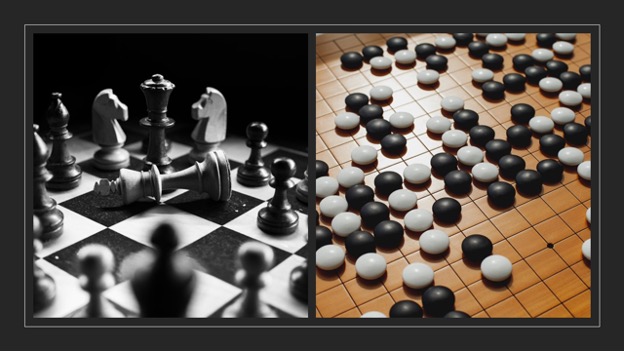
Contrasting Chinese and American Approaches to Irregular Warfare
Sal Artiaga – Irregular Warfare Practitioner
In the grand theater of global conflict, the strategic mindsets of the two world powers are often best summarized by the ancient board games of Chess and Wei Qi (Go). These games, emblematic of divergent cultural philosophies, illuminate the contrasting approaches to irregular warfare adopted by the United States and China. Chess, with its focus on the decisive defeat of a singular king, mirrors the direct, force-centric tactics of American military strategy. In stark contrast, Wei Qi, with its slow encirclement and control of territory, reflects the Chinese penchant for gradual, indirect methods and long-term strategic positioning. This article delves into the depths of these distinct strategies, exploring how they shape each nation’s unique conduct in the realm of irregular warfare, where the battle is not only for territory but for the hearts and minds of people and the influence over global affairs.

The Philosophical Underpinnings
The strategic philosophies guiding American and Chinese military approaches are vividly symbolized by the games of Chess and Go, respectively. Chess’s pursuit of a swift checkmate mirrors the American strategy of direct, forceful engagement aimed at decisive outcomes and clear victories. This approach prioritizes immediate, tangible results, such as the collapse of enemy leadership or the quick cessation of hostilities, aligning with a Western preference for finite conflicts and definitive endpoints.
In stark contrast, Go’s slow encirclement strategy encapsulates China’s historical penchant for indirect, patient confrontation, reflecting a preference for long-term strategic positioning and influence. Unlike the direct assaults in Chess, Go emphasizes a gradual accumulation of advantage across the board, which in a military sense translates to a broader, more sustained campaign of accruing power and influence without triggering outright conflict. This methodical approach implies a more nuanced, long-duration conflict style, aiming to shape the geopolitical environment subtly and steadily over time. Understanding these divergent philosophies is critical for deciphering each nation’s conduct in the realm of international relations and irregular warfare, where direct force and strategic patience often collide.
Top of Form
Chinese Approach to Irregular Warfare
The Chinese way of irregular warfare is deeply rooted in historical doctrines and the wisdom of ancient strategists like Sun Tzu. Their irregular warfare strategies underscore the importance of subversion, intelligence, leveraging local populations, and winning without fighting. The art of deception, camouflage, and psychological warfare are vital components, reflecting the intricate maneuvers of Go, where the objective is territorial control through strategic encirclement.
China’s modern irregular warfare strategies embody this ancient wisdom. The country leverages multiple facets of power – economic, political, informational, and military – to incrementally expand its influence. Cyber warfare, economic coercion, and strategic infrastructure investments globally exemplify China’s irregular tactics aimed at gradually reshaping the geopolitical landscape in its favor.
American Approach to Irregular Warfare
Contrastingly, the American approach to irregular warfare, symbolized by chess, is characterized by a focus on direct engagements, decisive actions, and technological superiority. The U.S. relies heavily on its advanced military capabilities, specialized units, and coalition partnerships to confront and neutralize threats. The strategic objective often revolves around dismantling hostile leadership structures, akin to targeting the king in chess.
However, the American irregular warfare approach is not monolithic. Lessons learned from counterinsurgency operations, nation-building endeavors, and civil-military collaborations have enriched the American irregular warfare repertoire, integrating elements of cultural understanding, population-centric strategies, and psychological operations to complement its technological and tactical advantages. An integrated approach to irregular warfare, but still focuses on a linear approach with the king as the main target.
Comparative Analysis, Strategy & Adaptability
While the Chinese employ a patient, long-term strategy aiming for incremental gains and influence, the Americans often seek immediate, tangible results. This divergence is reflected in the flexibility and adaptability of their respective irregular warfare tactics. The Chinese approach, like a Go game, requires adaptability, the ability to seize opportunities, and a willingness to retract when faced with stronger resistance. The American approach, symbolized by chess, necessitates foresight, strategic planning, and the ability to capitalize on the adversary’s vulnerabilities.
The inherent adaptability and strategic patience of the Chinese way of irregular warfare could potentially offer an advantage in protracted conflicts, enabling China to adjust and optimize its strategies based on evolving dynamics. In contrast, the American focus on technological superiority and decisive actions lends itself to achieving swift and conclusive victories but may face challenges in sustaining long-term engagements and adapting to fluid, irregular conflict landscapes. This is something that we have seen transpire in both Vietnam and Afghanistan, where battlefield engagements were won by the American forces, but the long duration of the conflicts eroded the political will to continue fighting, leading to withdraws.
Synthesizing the Strategic Playbook for Irregular Warfare
The examination of the Chessboard and Wei Qi offers profound insights into the prevailing American and Chinese strategies in the realm of irregular warfare. These contrasting approaches reflect deeper philosophical underpinnings and historical predilections that have shaped each nation’s military tactics and geopolitical maneuvers. While the United States often embraces a chess-like strategy that seeks the decisive defeat of key pieces to claim victory, China’s Wei Qi-inspired approach focuses on strategic encirclement and the subtle acquisition of influence across the global board. The Belt and Road initiative is a clear example of this approach. Go players aim to surround their opponent’s stones to gain control. With the Belt and Road initiative, China is building infrastructure and investments in countries along key trade routes. This can be seen as a form of economic encirclement, where China seeks to exert influence over these nations through economic ties.
The American method, with its technological prowess and emphasis on immediate outcomes, demonstrates strength in rapid, impactful results but may falter in protracted engagements where a nuanced, adaptive strategy is paramount. Conversely, China’s gradualist tactics, reminiscent of Wei Qi’s patient spread across the board, allow for a flexible response to the changing dynamics of global conflict, though this approach may lack the immediacy necessary to respond to sudden threats or crises.
As the international arena continues to evolve, it may become increasingly necessary for these superpowers to recognize the strengths and limitations inherent in their preferred styles of play. By integrating the directness of chess with the patience and adaptability of Wei Qi, a more holistic strategy can emerge—one that is responsive to the immediate challenges of global conflict while maintaining the foresight to secure long-term strategic objectives. The future of irregular warfare, therefore, may not rest in the dominance of one approach over the other but in the ability to harmonize these diverse strategies to navigate the complex and unpredictable tapestry of global affairs.
